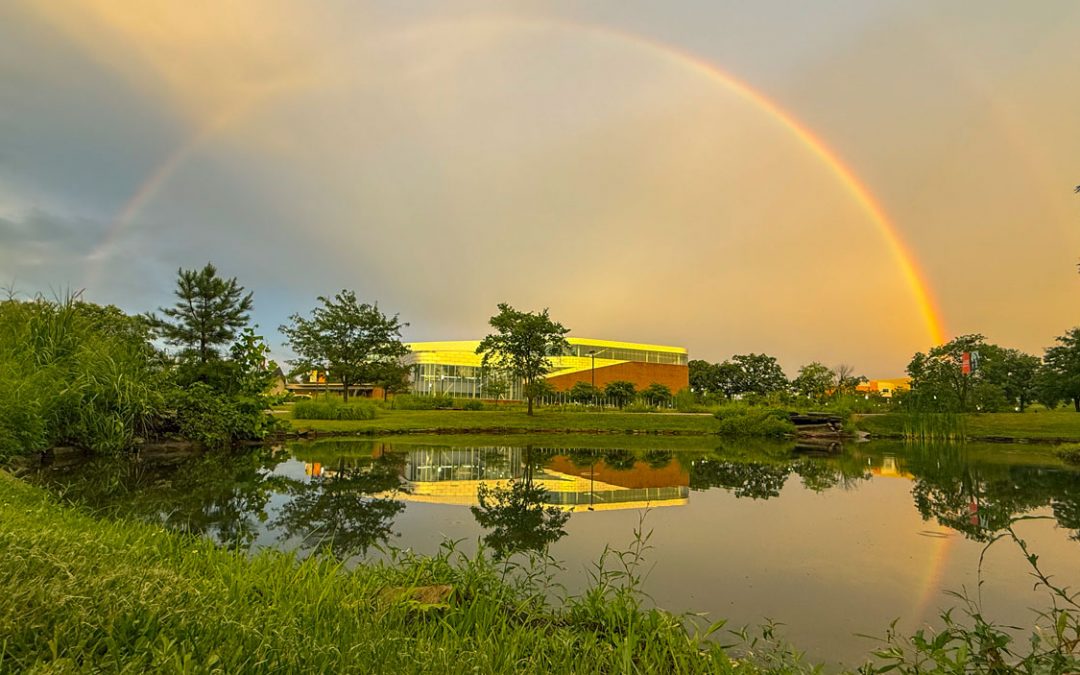
Theresa Coble (front row, right), the E. Desmond Lee Endowed Professor of Experiential and Family Education, and a group of former students at St. Louis Lambert International Airport excitedly prepare to travel to a National Association for Interpretation conference. The photo was recently featured on the front page of NAI’s 2021-2023 strategic plan. (Photo courtesy of Theresa Coble)
For some, the word “interpretation” might evoke translating between two languages.
However, in education, interpretation refers to the discipline of helping people find meaning and facilitating connections at informal learning sites outside of the classroom. These sites celebrate important natural, cultural and historical resources and include places like national parks, museums, zoos and even commercial ventures like breweries.
Theresa Coble, the E. Desmond Lee Endowed Professor of Experiential and Family Education at the University of Missouri–St. Louis College of Education, has been instrumental in advancing the field for more than two decades.
Coble started the first master’s program in interpretation at Stephen F. Austin State University in the early 2000s, and the National Association for Interpretation bestowed upon her the 2019 Fellow Award for her professional contributions.
She’s continuing to guide the profession forward, playing a crucial role in developing NAI’s new definition of interpretation and authoring an article on the nuances of the new definition in the September-October issue of Legacy, the organization’s professional magazine.
The new definition reads: “Interpretation is a purposeful approach to communication that facilitates meaningful, relevant and inclusive experiences that deepen understanding, broaden perspectives, and inspire engagement with the world around us.”
“I’m super happy with this definition,” Coble said. “I’m so happy to lead the development of a new definition for the field, and this process puts UMSL front and center.
“I think this definition will help people who have no idea about interpretation. That’s one of the common things when you say, ‘I work in the field of interpretation.’ People ask, ‘What foreign language?’”
Coble has spent her career advancing interpretation and experiential learning because it has the power to inspire people to engage meaningfully, thoughtfully and critically with the world around them. It also brings people together, nurturing the bonds of community. In her view, the new definition perfectly captures this potential.
Her work on this new formulation started in 2018, when she was appointed chair of NAI’s Definitions Taskforce. Over the years, people have defined interpretation in various ways, but the National Park Service’s view on the matter greatly influenced NAI’s earlier definition.
It stated, “Interpretation is a communication process that forges emotional and intellectual connections between the interests of the audience and the inherent meanings in the resource.”
The definition was useful in many ways.
“Many interpreters find that a dual emphasis on intellectual and emotional connections is really important for effectiveness,” Coble said.
However, there was also room for improvement.
“One problem with the old definition is the phrase, ‘a communication process that forges…’ It’s like you’re beating something or molding someone with a hammer on an anvil. So, it lacked a sense of visitor agency.”
After years of work, and multiple rounds of professional engagement, NAI board members came to a consensus and voted to change the definition in August. In her Legacy article, Coble explained that it represents an opportunity to move the field forward while maintaining through lines to the past.
The article introduces the new definition while contextualizing key terminology and concepts related to it.
One central issue is the approach to communication in the 21st century and whether past approaches are currently adequate. In the digital age, information and various forms of media have become more accessible than ever. Thus, audiences at informal learning sites expect participatory exhibits and communication to flow in multiple directions, and interpreters must adapt accordingly.
To do this, interpreters should facilitate experiences to engage audiences rather than lecturing. Coble said this a departure from the “sage on the stage” model where communication flowed one way from a subject matter expert.
“This idea of ‘sage on the stage’ has yielded to a different framing of interpretation where we function as ‘guides on the side,’” she said. “People need to have experiences encountering the place and each other in multiple ways that facilitate mutual learning and engagement, and interpreters guide the process of inquiry and discovery.”
Coble said one of the most effective ways to do this is with essential questions. For instance, at the Lincoln Memorial, an interpreter might ask an audience, “What does freedom look like in a divided society?” or “How do you think we can ‘build a more perfect union’?” These questions create more points of engagement and bring different people’s perspectives into the discussion.
Inclusion – prioritizing differing experiences and perspectives – is also an important aspect of the new definition. Coble said NAI has strengthened its commitment to inclusion, diversity, equity and accessibility, and sites that celebrate important cultural, historical and natural resources can unite people from different backgrounds.
“Many of us view our public heritage sites as places where people can come together across differences and over their lifespan,” she said. “We can come together and think about the meanings and significance of these sites and have dialogue with each other.”
In addition to tapping Coble to write about this new development, NAI also featured a picture of Coble and a group of UMSL students, faculty, and staff on the cover of its 2021-2023 strategic plan. For Coble, it’s a testament to UMSL’s place at the forefront of the interpretation field.
“In the strategic plan for 2021-2023, the number one new goal is to strengthen diversity, equity and inclusion in NAI,” Coble said. “UMSL’s doing it, and UMSL gets some prominence because of our leadership in this area.”














